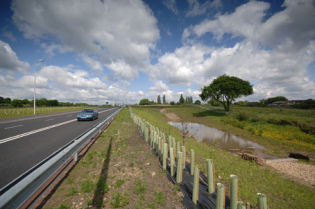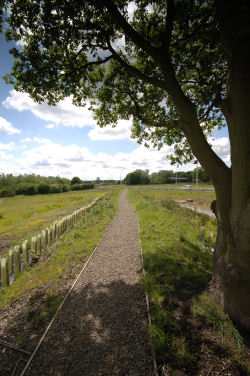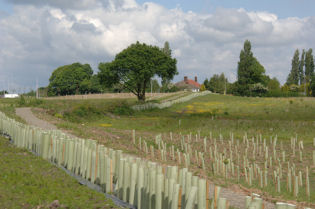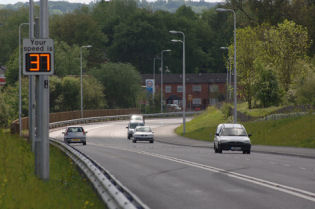A58 Blackbrook Diversion SchemeWinner of a CEEQUAL Outstanding Achievement Award 2011 for Ecology & Biodiversity |

86.5% |
Whole Project Award
Project Team:
Client: St
Helens Council
Designer: Gifford
Contractor: Birse
Civils
The Project
 |
|
|
The A58 Blackbrook Diversion has successfully removed 20,000 vehicles a day from the village of St Helens. The new road, a single-carriageway bypass involving 1.6 km of new road and a new roundabout, runs close to Clipsley Brook and passes over Black Brook, which has been diverted through a new culvert.
 |
|
The scheme design included the following:
- providing mitigation for sensitive habitats and species impacted by the scheme
- creating additional conservation areas
- integrating the landscape and ecological principles outlined within the Stanley Bank Environmental Planning Framework
- provision of a Sustainable Drainage System incorporating new ponds and wetlands to alleviate flooding
- landscaped bunds and acoustic fencing
 |
|
Sustainability embedded from the outset
The bypass runs through one of the most environmentally important areas in St Helens, with a local nature reserve, Stanley Bank Site of Scientific Interest (SSSI), and Semi-Natural Ancient Woodland sitting alongside industrial remnants, such as an iron-slitting mill. A proactive approach to sustainability ensured environmental issues were embedded into the centre of the project rather than as a statutory bolt-on.
The team benefitted from the expertise of the Environment Agency, local stakeholder groups and regional advisory groups. The project team was therefore able to draw on the local and technical knowledge of a wide range of individuals and organisations, ensuring that ideas and innovation were integrated into the wider project.
 |
|
| |
Environmental and community benefits
The bypass:
- significantly reduced traffic on West End Road, improving the environment and safety
- improved access to St Helens for commercial traffic, assisting the economic regeneration of the town
- included extensive landscaping, sympathetic to the character of the area, to enrich the wildlife habitat of formerly intensively farmed land
- allowed the creation of wetlands and grassland, benefitting water voles and dragonflies, whilst woodland and scrub planting provided nesting space for a variety of birdlife
- improved access to Stanley Bank area by providing new recreational footpaths
 |
|
| |
Sustainability in planning, procurement and design
A detailed Environmental Impact Assessment was conducted by St Helens Council. After extensive planning consultation, it was considered important that the scheme enhanced and expanded the natural habitat and environment for the benefit of the local community.
From the outset, St Helens were determined to achieve “something special” in terms of environmental sustainability. The use of Early Contractor Involvement with Birse Civils and their designer, Gifford, enabled St Helens Council to develop a strong commitment within the team to delivering this from design through to construction.
 |
|
| |
Improved management processes
A meeting was held in the early stages of the project to identify practices to manage or mitigate environmental risks and add environmental value to the project. This involved all stakeholders to capture everyone’s aspirations for the project.
A number of environmental management processes were introduced to ensure environmental issues remained at the forefront. Central among these were the Construction Environmental Management Plans (CEMP) and Site Waste Management Plans (SWMP). The SWMP was developed using guidance from the Department of Trade and Industry, Envirowise and the Groundwork Trust and was implemented on a voluntary basis by the project team to deliver best practice.
 |
|
| |
Protection of wildlife, habitats and the local ecology
The team utilised specialist expertise to protect key wildlife within the site:
- Prior to commencement, a survey undertaken by the project team identified a population of water voles near to the construction footprint. A trained ecologist relocated the water voles until construction work was completed.
- The Environmental Impact Assessment identified the presence of bats roosting at the site together with a number of environmental features supporting this population. During construction, a survey was undertaken by a bat ecologist of all habitat features that could be affected. The long-term wellbeing of the population was supported through habitat connectivity, sensitive use of street lighting and the installation of numerous bat boxes around the site.
- The local area was identified as an important area for wintering birds and sensitive timing of works such as scrub clearance was required to avoid the bird nesting season.
Sustainable Drainage System (SUDS)
The implementation of a Sustainable Drainage System was a main planning consideration, forming part of the Stanley Bank Environmental Framework.
Designed to address the problems of traditional drainage schemes, the attenuation ponds within the SUDS store surface water, which is later dissipated through natural means, i.e. solids can settle and water is filtered back naturally into the substrata.
The development of the SUDS also improved biodiversity by creating a natural habitat for water voles, dragonflies, invertebrates and moths. The scheme made a major contribution to the North Merseyside Biodiversity Action Plan.
Management of invasive weeds
A number of invasive weeds, such as Japanese Knotweed and Himalayan Balsam, were identified during the Environmental Impact Assessment. These were considered detrimental to the indigenous flora and the integrity of the road. A specialist subcontractor used a combination of excavation and spraying to remove the weeds using a Knotweed Eradication Strategy that followed the Environment Agency’s Code of Practice.
No materials were taken off site, instead the materials were relocated on site for treatment and to be developed into a feature for the St. Helens Gateway on completion of the treatment regime.
Energy efficiency
The project addressed energy efficiency in a number of ways, including looking at the introduction of renewables and energy efficiency for the lighting on the site. A Mayflower Intelligent Management System (MIMS) was implemented for more specific control of the lighting. Improved efficiency was achieved through the following measures:
- Lux capacity can be adjusted to suit the requirements of the user, allowing lighting to be dimmed late at night when traffic is minimal, thus saving energy and reducing light pollution.
- MIMS can predict bulb failure, which is important, as failing bulbs use more energy.
- Energy consumption can be measured, allowing savings over traditional billing methods.
- The use of down-lighting along the road reduced disruption to local bat roosts.
Waste and resource efficiency
An Envirowise Site Audit addressed exactly what waste was being produced and its location, so it could be reduced. The site audit helped to:
- identify what was being done
before the resource efficiency initiative was started
quantify the environmental and financial savings made. - An informal target of ‘10% recycled content by materials value’ was set for the scheme. This target was exceeded with an impressive 76% total recycled achieved.
Biodiversity
An independent audit assessed how biodiversity issues were considered during the planning process, how they were undertaken during construction, the quality of monitoring and management of the outcomes. By identifying key assessment areas, the team was able to effectively identify and embrace nationally recognised best practice.
Measuring performance
Environmental performance was measured on Blackbrook to determine the success of innovation and management processes. The scheme achieved the following:
- Impact on the environment, measured by customer satisfaction, at 95%
- Customer satisfaction for Impact on Biodiversity at 95%
- The habitat area created and retained in the project is 47%
- Level
of recycled elements within the finished product,
measured at 76%
